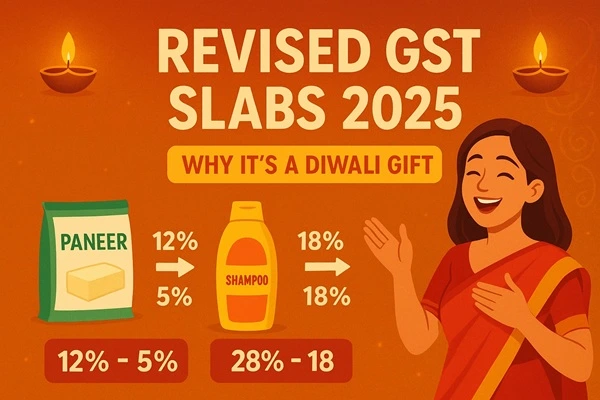If there’s one headline every Indian consumer should know this festive season, it’s this: GST in India has been simplified and many products are about to get cheaper.
On September 22, 2025 (the first day of Navratri), India will officially move to a new GST structure. This isn’t just a technical tax change, it’s a major reform that could affect your grocery bill, your Diwali shopping, your home renovation costs, and even your insurance premiums.
So, what exactly has changed? Let’s break it down step by step without jargon so you know exactly why people are calling this a “Diwali gift from the Government.”

Revised GST Slabs 2025 : From 5 Slabs to 2 (Plus a New One at the Top)
Until now, India had five main GST slabs: 0%, 5%, 12%, 18%, and 28% (with some extra cesses). It was confusing for businesses, frustrating for consumers, and full of classification disputes.
From September 22, the GST Council has scrapped the 12% and 28% slabs. The new system looks like this:
- 0% – Essentials (unprocessed food, certain basic goods)
- 5% – Daily-use items
- 18% – Standard rate for most goods and services
- 40% – A new slab for luxury and sin goods (tobacco, high-end cars, etc.)
Why this matters: Fewer slabs = simpler bills, less confusion, and clearer prices.
Revised GST Slabs 2025: What Gets Cheaper (And What Won’t)
Here’s the part that matters most for your pocket. Let’s look at category by category:
1. Daily Essentials & FMCG
- Paneer, ghee, namkeen, packaged foods → Now 5% (earlier many were 12%).
- Toothpaste, shampoos, hair oil, toothbrushes → Now 5% (earlier 12–18%).
- Common medicines → Now 5% (earlier 12%).
Your monthly grocery + personal care + basic medicine bill just got lighter.
2. Home Appliances & Electronics
- Air-conditioners, fridges, washing machines, TVs, projectors, dishwashers → Now 18% (earlier 28%).
- Mainstream electronics, mobile phones → Standardized under 18%.
Big-ticket festive purchases are 10% cheaper in tax terms.
3. Housing & Construction
- Cement → Now 18% (earlier 28%).
Cheaper cement could mean lower construction costs and savings on home renovations.
4. Automobiles
- Mid-size and big cars (non-luxury) → Tax burden reduced (earlier 28% + cess).
- Luxury cars & SUVs → Fall into the new 40% slab, so they’ll remain expensive.
The family car market will likely see price cuts and festive offers, while the luxury segment stays taxed heavily.
5. Insurance & Financial Services
- Life and health insurance premiums → Exempt/0% GST (earlier 18%).
Covering your family’s health and life is now more affordable.
6. Apparel & Energy
- Premium apparel (above ₹2,500) → Will get costlier due to higher slab adjustment.
- Coal → Higher GST, balancing revenue and environmental concerns.
Everyday clothes stay the same, but designer fashion costs more. Coal-linked sectors may see price pressures.
7. EVs & Agriculture
- Electric vehicles & farm products → Continue in low slabs to support growth and sustainability.
No change here—still incentivized.
Why It’s Being Called a “Diwali Gift”
Three big reasons:
- Household savings – Essentials, personal care, medicines, and durables all get cheaper just in time for festive shopping.
- Boost for consumption – Cheaper products during Navratri and Diwali mean higher demand in FMCG, electronics, autos, and housing.
- Simpler tax system – Fewer slabs means businesses face less confusion and you face fewer billing disputes.
How Will It Impact the Indian Economy?
- Inflation: Analysts expect inflation to drop by up to 1.1%, giving real relief to household budgets.
- Growth: Cheaper durables and construction materials could increase demand, supporting GDP growth.
- Government revenue: Yes, the government will lose about ₹48,000 crore in tax revenue. But that’s much smaller than earlier feared. Higher consumption and the 40% slab on luxury/sin goods will help balance things.
- Businesses: Small shopkeepers and MSMEs get a simpler system, easier invoicing, and fewer disputes.
Quick Comparison: Old vs New GST Rates
| Category | Old Rate | New Rate | Impact |
|---|---|---|---|
| Groceries (paneer, ghee, namkeen) | 12% | 5% | Cheaper |
| Personal care (toothpaste, shampoo, oil) | 12–18% | 5% | Cheaper |
| Common medicines | 12% | 5% | Cheaper |
| White goods (AC, fridge, TV, etc.) | 28% | 18% | Cheaper |
| Cement | 28% | 18% | Cheaper |
| Mid-size cars | 28% + cess | Reduced | Cheaper |
| Luxury cars | 28% + cess | 40% | Costlier |
| Life/health insurance | 18% | 0% | Cheaper |
| Premium apparel | 12–18% | Higher | Costlier |
| Coal | Lower slab | Higher | Costlier |
What You Should Do as a Consumer
- Delay big-ticket purchases like ACs, TVs, cars, and cement-related renovation until after September 22
- Check insurance premiums again, your family cover might be more affordable now
- Look for festive offers—brands are likely to combine GST savings with Diwali discounts
My Personal Take
This GST reform feels like a win-win. For once, the government has balanced simplicity, affordability, and revenue protection. Two slabs make life easier for everyone. Essentials and big-ticket durables get cheaper, which should spread festive cheer across middle-class households.
The only catch? We need to see if businesses pass the benefits on fully. If they do, we’ll truly feel the difference in our wallets this Diwali.
FAQs on Revised GST Slabs 2025
1. When do the new GST rates start?
From September 22, 2025 (Navratri Day 1).
2. What are the new Revised GST Slabs 2025?
0%, 5%, 18%, and a special 40% for luxury/sin goods.
3. Which products got cheaper?
Groceries, personal care items, medicines, consumer durables, cement, many cars, and insurance premiums.
4. Which products got costlier?
Luxury cars, designer clothes above ₹2,500, and coal.
5. Will prices drop immediately?
Yes, but some retailers may take a few days to reprint price tags.
6. How will this Revised GST Slabs 2025 affect inflation?
It could reduce inflation by about 1.1%.
7. Will government revenue suffer?
Yes, by around ₹48,000 crore, but it’s manageable and offset partly by the luxury slab.
8. Should I wait for purchases?
Yes—plan major buys after Sept 22 to take advantage of the new rates.
Final Word on Revised GST Slabs 2025
This festive season, the Indian Government’s GST reform could make Diwali shopping lighter on your pocket and brighter in your home. From groceries to gadgets, the savings will add up. And that’s why everyone—from kirana stores to families—is calling it a Diwali gift.
For more such Latest Trending News and Updates, Follow Popnewsblend.com.

Hi, I’m Prashant Jain — a curious soul, storyteller, and content creator at heart.I’ve always been drawn to the world of entertainment, travel, sports, health & lifestyle — not just as a writer, but as someone who genuinely lives these experiences. Whether I’m binge-watching the latest OTT series, exploring offbeat spiritual destinations in India, or diving deep into wellness routines and cricket match insights, I love sharing what I discover with like-minded readers.
PopNewsBlend is my way of blending personal journeys with meaningful stories — ones that inform, inspire, and keep you ahead of the curve. Everything I write comes from real observations, hands-on experiences, and a deep passion for understanding the world around us.
Discover more from Popnewsblend
Subscribe to get the latest posts sent to your email.







